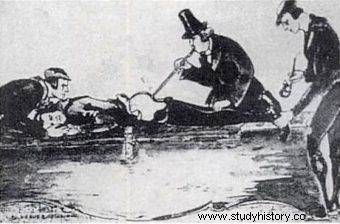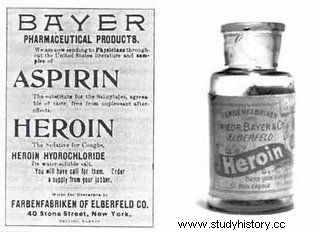Meet 4 examples of some of the worst treatments ever. They wonderfully prove that once a medicine could be worse than… a disease! Only for people with strong nerves.
Fear of disease and death made charlatans able to convince people of the most absurd drugs and treatments. At best, some of them simply did not work, more often - they harmed, at worst - they killed.
Rubbing toothpaste with mercury on the gums of newborns
Calomel was a very popular remedy that was used as a medicine since the 16th century. Benjamin Rush used it to treat patients in mental hospitals and patients infected with yellow fever. But it was also the main ingredient in the teething powder. Concerned parents rubbed it on the gums of their children, believing that it would bring relief to the suffering babies. In an ad for Teethina powder, Dr. Moffet was convinced that it would not only ease the pain, but also strengthen the child, eliminate defecation problems and "make the baby fat like a piglet!" There was little concern that mercury was a component of calomel.

Tobacco enema as a way to save… drowned people.
The effects of the treatment were tragic:
The baby's hands and feet were ice cold, swollen and red. The skin was peeling, just like a burnt tomato peeling from the flesh. The girl lost weight, she cried in exasperation, and because of the persistent itching, she scratched herself furiously, tearing her skin to live flesh.
The mercury treatments were not discontinued until the beginning of the 20th century.

"Teethina will make the baby as fat as a piglet!"
Radioactive spa
The discovery of radium by Maria Skłodowska-Curie and Pierre Curie was received with absolutely enthusiasm in the medical community. This element has been shown to have an amazing ability to destroy cancer cells. Unfortunately, it was not discovered then that ... it kills very effectively.
In 1924, William Bailey announced that "By ionizing the glands, we have encircled all disorders, diseases, old age, and even life and death." For some time, doctors believed that ionizing radiation served the health of the body. Bailey argued that the effects of aging can be delayed by radiation . No wonder people are crazy about this invention. Bathing in radioactive sources has become very popular. Special hotels with a very rich offer were built. Apart from baths, inhalations directly from pipes connected to the process tank were proposed. In some hotels, the entire interior was specially irradiated. In the early 20th century, radiation was just in vogue.
An analysis of the health problems of researchers experimenting with radium led to a gradual shift away from therapy. The invention of the Geiger counter helped. It was not until the 1980s that the use of radium for medicinal purposes was almost completely discontinued. Today, the radium isotope is used as standard therapy for some stages of cancer.
Heroin as a drug against morphine addiction
As part of the development of a non-addictive version of morphine, Alder Wright synthesized diacetylmorphine, which was then tested at Bayer. One of the employees said he felt heroic after taking it . This is how heroin hit the market. By 1899, Bayer was already producing a ton of heroin a year! Pills, sweetened lozenges, powders and syrups were sold. It was also prescribed for the treatment of morphine addiction.
The ads were enthusiastic:
Heroin cleanses the skin, makes the mind sharp, improves the work of the stomach and intestines - it is the perfect guardian of our health.
Elsewhere it was praised:
It is superior to morphine in many ways ... It is not hypnotic, and there is no risk of falling into addiction.

Bayer Heroin Advertising
Heroin was banned in the United States as early as 1924, but an entire generation was dependent on it at the time.
Tobacco smoke enemas
One of the most absurd medical ideas was tobacco smoke enemas. The circles of doctors in Great Britain promoted them in the 18th century in order to resuscitate drowned people. At that time, a strange institution was established:the Organization for Immediate Aid to Seemingly Dead People in the Aftermath of Drowning. Its members traveled the banks of the Thames and looked for drowned people who were given tobacco enemas as part of their resuscitation.
The strangest thing - for some time the bellows were not included in the kit to perform the procedure and the "rescuers" were simply blowing smoke into the anus of the rescued person . This was to heat the body and stimulate breathing - against logic and against any medical knowledge, of course. There have been cases of death of rescuers if they accidentally sucked cholera bacteria in this way.
However, the absurdities did not end there. If the method failed, it was decided to perform artificial respiration, considered much more "vulgar" than previous attempts to restore life.

Tobacco enema kit
As you can see, man was very innovative when it comes to saving health. Fortunately, today we live in completely different times.
Trivia is the essence of our website. Short materials devoted to interesting anecdotes, surprising details from the past, strange news from the old press. Reading that will take you no more than 3 minutes, based on single sources. This particular material is based on the book:
- Lydia Kang, Nate Pedersen Charlatans. The worst ideas in the history of medicine. Publishing House of the Jagiellonian University 2019.
